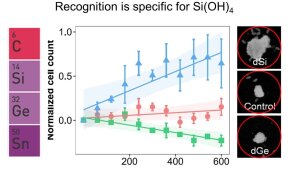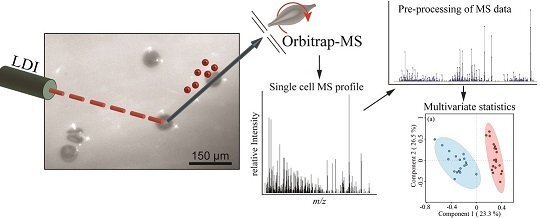Chemically mediated interactions in the benthos
Here we focus on two major topics: i) the pherome chemistry of diatoms and ii) the role of metabolites in the structuring of biofilms.
Diatoms
Image: Diatoms recognize and orient towards dissolved silicate but avoid the toxic dissolved germanium dioxide. https://www.nature.com/articles/ncomms10540Biofilm formation in the marine environment is highly dependent on a complex signaling chemistry. The pheromone chemistry of microalgae plays a central role in structuring the community. We described the first diatom pheromone as a first member of a complex signal cascade that is currently under investigation in our labs https://onlinelibrary.wiley.com/doi/full/10.1002/anie.201208175External link.
We also realize that bacteria play a central role in the regulation of such pheromone signaling since pheromone degradation mediated by these co-occurring partners or competitors in biofilms is observed. The additional role of surface signals that can include even the availability of mineral resources is currently under investigation in video monitoring experiments of biofilm dynamics and cell movement.
Diatoms recognize and orient towards dissolved silicate but avoid the toxic dissolved germanium dioxide. https://www.nature.com/articles/ncomms10540External link
To unravel the role of patchy metabolite distribution in such biofilms we also develop new MS- and Raman based imaging techniques that allow monitoring of chemical landscapes down to a single cell resolution.
Imaging
Image: ImagingA Raman-Microscopy generated map of fucoxanthin distribution in a biofilm. Left: Chlorophyll fluorescence of individual diatom cells. Right: Distribution of Fucoxanthin. The Square has a 100 µm side length.
The concept of investigation of biofilm formation outlined above is also expanded to include an additional biotic partner. Biofilm formation in the marine environment is by no means restricted to abiotic surfaces but macroalgae also provide a substratum for settlement of microbial organisms. Here we expand the concepts for biofilm investigation to include the additional aspect of the surface chemistry of the host. Again, chemical imaging, surface manipulation and metabolomic investigation of surface communities in the context of substrate signals is in the focus of our work. Since host physiology plays a central role in this context we also address how the macroalga responds to challenge by settling organisms and how induced and activated processes contribute to resistance or targeted shaping of biofilm communities.
See our publications for more information

